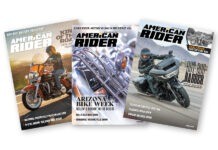Along with all its other accomplishments, the X-series Harley-Davidson engine/tranny/primary “platform” (Sportster, to most of us) has “motored” at least four different “cycles.” To its credit—with variations and updates along the way—it has done, and continues to do, an “XL-ent” job at widely disparate tasks over the decades of its existence. But it’s the “cycle” part that completes the package, so I thought it might be instructive to undertake a basic overview of the machines that are out there, for the benefit of potential owners. Call it the “X-factor.”
We need to get a few things straight before we start, though. This is not a buyer’s guide. I don’t know or care about the ups and downs of detailed deviations between, say, an “Iron 883” and a “Seventy-Two.” This ain’t no fashion show. More use will come from dissecting the powertrain and chassis. Another thing: no real attention will be paid to older (four-speed) stuff. These machines, dating clear back to 1957 and as new as 1990, remain in most ways superior, in terms of reliability, power and simplicity, not to mention affordability than any Big Twin. All the same, these bikes have notable flaws. But, starting in 1991, with the introduction of a five-speed transmission, the Evolution XL has been a very hard thing to criticize in meaningful ways. Especially in light of the Buell “connection,” which, beginning in the early ’90s, laid the groundwork for a performance renaissance, which has kept the X-engine in the fight since then. Not to say that an old-fashioned, air-cooled, pushrod V-Twin has it over modern designs from practically every other manufacturer… but there are advantages all the same. Hell, I could write a book (and did many years ago) but there’s no room for all that here. It’s time we went exploring…
The Sign of Four
1) Sportster 1991 to 2003: Largely unchanged from inception to demise, this is arguably the purest, most elemental (some would say best) motorcycle ever built… by anyone. Today, as used bikes, finding quite an audience among (Ahem!) mature, experienced riders, it was the Sportster that killed off any notions about being an “entry-level” Harley, useful only for trading up to a Big Twin at a later date. These Sportys are desirable on their own merits and aside from fuel capacity issues serve as well for distance rides as they do around town.
Up front, the biggest nuisance is vibration at speed, as the last of the “solid-mount” Harleys. But, it is not a deal breaker unless you plan to be ticket bait 24/7. Any legal-limit velocity is tolerable long term, with short bursts to the rev limiter invited. Another nice option is easy gearing changes, bigger front sprockets and “euro” rears, allowing a rider to move the vibe zone out of cruising range, if so desired.
Moreover, the power plant routinely manages 80–100,000-mile durability in the top end and more out of the bottom end and tranny… with any semblance of maintenance, that is. Let’s not forget that maintenance is also much easier than it is on Big Twins as well, not least because the “cassette” transmission has a “trap door,” obviating the need to split the cases—just in case.
One bug-a-boo of the machines from this era is the infamous “oil in the air cleaner” issue, which seems to afflict some more than others. Rest assured, there are effective workarounds if not a permanent cure; mostly involving routing breather hoses to the ground (or a catch tank), rather than back into the air cleaner.
It should go without saying (but I will anyway) that these Sportsters can also be customized and tailored to suit the owner’s wants and needs to a huge degree. Whether it be larger or smaller fuel tanks, handlebars, brakes, wind protection, hop-ups or damn near anything else your heart desires, the original five-speed Sportster in 883 or 1200 form fills the bill for the vast majority of real riding requirements.
2) Sportster 2004 to present: Intended to expand the envelope of Sportster “virtues” while eliminating the vices, the so-called “rubber mount” XL has been a resounding success. The isolation from vibration has opened up the appeal of the bike to a wider audience than ever, and makes this Sporty the one you never have to apologize for. It does everything well. Pity about losing the trap door transmission, but how often lately has a Sporty tranny really needed an overhaul anyway? It’s a largely academic demerit, mostly in the opinion of purists. The real downside to the current Sportster is the 50-plus pounds gain in weight—they are real heavyweights these days! The versatile gearing swaps of yore are not nearly as easy either, but less a concern, so that’s a wash for most riders. The oil in the air cleaner issue is a history lesson… one Harley learned well. Still aimed at the younger rider, one lesson Harley has sorta botched is eliminating a “standard” version of the Sportster, in favor of 19 kinds of “custom” models, thus alienating a great many not-so-young riders. Not that it matters much; the new bikes are selling better than ever! Since the “grapevine” is pretty quiet regarding any meaningful problems with the rubber XLs, it’s safe to say these might just be the best ever! (Although I was tempted to say most “XL-ent.”)
3) XR1200 2008–2010: OK, now we begin to see what happens when The Motor Company narrows the focus of an X-engined offshoot… by popular demand, no less! It happened before, when the iron Sporty was drafted into service as a cafe racer back in the late 70’s. Totally tarted up, unsuitable and unsalable at the time (although collectible now) the XLCR taught the factory that if they ever pulled such a stunt again, it would need to be a unique piece built for the job. Enter—30 years later—the XR1200! Perfect (nearly) for the intended market, which, it turned out, was mostly European and quite small. Jeez, a Harley that could be ridden flat out on the Autobahn and handled well enough to road race—what more could you ask? Well, see the comments on versatility in numbers 1 and 2 for the answer to that. Turns out, more folks prefer a blank canvas to a stunning portrait… so to speak.
Once everybody had one that wanted one, sales fell off a cliff and H-D killed the beast, once again teaching its creators that narrow appeal will never lead to a wider audience. Damn shame! Never mind that the big XR was one whale of an accomplishment! Truly for connoisseurs, with great suspension, unique chassis, top-shelf brakes, patented pressurized “ram” air box, oil-cooled heads (oil-cooled heads!) and much more… it was a delight! A bike for hard-riding Harley fans, with performance potential not seen on any other Sportster variation ever, which includes the last hot-rod effort by H-D, the XR1000. Too bad it was just not a machine that would look right with a sissy bar, saddlebags and a windshield. Chalk that up to the street tracker style if you want, but looks aside, it was the only Harley since the late-lamented FXR that I personally would break the bank for. The resale prices of the XR1200 today tell me I’m not the only one who missed out on a masterpiece.
4) Buell 1996–2010(?): Most of what made the power plant in the XR1200 the most effective X-engine ever originated with the bright lights at Buell, while an H-D subsidiary. Oil pumps upgraded then completely redesigned towards the end, racy camshafts, high-flow cylinder heads the likes of which did not grace regular Sportsters, exhaust layouts that flat out worked, ditto for intakes… the list goes on, and on, and on! And those are just the tube-frame era advances! Using H-D R&D money to develop the single-cylinder “Blast,” Buell essentially used what was learned from that program to reinvent the XL-type V-Twin along the way. Almost no part of the existing engine was shared with the XB-series bikes on their debut in 2003. One hundred honest horsepower from an engine layout that was formerly stuck at about 65—on a good day—tells the story. But Buell fans know all too well that for all its astonishingly increased performance, the new XB engines were evolutionary. What was revolutionary was a chassis, the whole damn thing, done by an ace, working from first principles. Harley fans didn’t get it. Hardcore sportbike fans didn’t either. The few who grew up around Vincents, Norton Commandos, BSA Gold Stars and such caught the glimmer. They understood that a proper combination of road holding and usable torque could make for a scintillating ride.
But it didn’t happen all at once. Most early Buells used near-standard Sportster engines and triangulated tubular frames with good shocks, light wheels and strange (but powerful) brakes. (Yes, I know the very first ones used XR1000 engines, but let’s stick to the five-speed era.) The chassis (and exhaust) alone meant that a Buell rider could leave any Sportster for dead! This plain fact also begged for more power, since that could put contemporary sportbikes in the crosshairs as well. Incrementally at first, that boiled down to a bit more power; thanks to heads, pistons and cams, and a lot less weight (mostly unsprung thanks to Italian wheels), along with a short wheelbase and a “centered” center of gravity. By 1998, the Thunderstorm engine and well-developed Uni-planer frame proved 100 hp and 450 pounds—sorted—could do better than expected against all comers, but was a dead end for future improvements.
Ah… but! Fuel injection and an “interim” frame/swingarm setup known as the X1 held the baton for a couple years, until Buell could lace two “Blast” singles onto a new set of proprietary crankcases (sans trap door) and up the ante on chassis design with a lighter-than-ever aluminum frame/gas tank and swingarm/oil tank.
Advertised dry weight—never near the truth—was still a massive 100 pounds lighter than the last of the solid-mount Sporties and nearly 125–150 lighter than the current rubber mounts! The XB engine, meanwhile, was no longer very close to ’91–’03 Sportster spec, with few interchangeable parts.
In fact, the new rubber-mount XL engine has derived more from Buell development than the other way around. A suitable legacy.
Horses for Courses
No doubt, the vast majority of those who read this already know what they like. No detail or data will make them stray from that like. I like it! Thing is, with four choices, some might also like new perspective before “the buy.” Lemme try… with some pictures, captions and commentary found nearby.



















